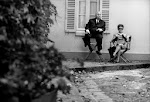Wednesday, March 28, 2007
Just the Beginning: The Art of Film Titles
Indeed, naturally I think that a film should have a beginning, middle, and an end—but not necessarily in that order.
Jean Luc Goddard
The main-title sequence—the opening credits—can be the most important moment in a film. Other than trailers and marketing elements, they are the first images the audience sees when the lights go down. These quick segments (all about two to three minutes) form a contract: outlining the filmmaker's intentions and setting up the expectations of those watching. Saul Bass, a graphic artist in the film industry said, "making a main-title was like making a poster—you're condensing the event into this one concept, this one metaphor…a backstory that needs to be told or a character that needs to be introduced."
The pioneering work of Bass in the fifties and sixties and its revitalization by Kyle Cooper and Imaginary Forces in the nineties, have elevated the opening credits to an art form. The title sequence has come to rival commercials and music videos as the leading indicator of contemporary visual style: dense and multi-layered—invariably more challenging than the film that follows it. This essay will examine two sets of titles that revolutionized the film industry: Saul Bass's North by Northwest (1959) and Psycho (1960), and Kyle Cooper's designs for Seven (1995) and Mimic (1997). Separated by more than 35 years, these credits blend similar methods and techniques to achieve new sensibilities and affect.
The earliest credit sequences were for silent films. They were presented on title cards—cards containing printed material that were photographed and later incorporated into the movie. These cards also included the dialogue and set the time, place and action for the scenes. As cinema evolved, so did the titles. After the implementation of sound, titles began to function as a transition: taking on the responsibility of displaying the movie's title, the name of the director and establishing the hierarchy of actors. In the 1950s, titles began to move beyond pragmatic communication and evolved into complete narratives—establishing the mood and visual character of the film.
Saul Bass was the industry's pioneer. His methodology embraced the modernist tenet of reduction and enforced an acute attention to pace, rhythm and detail. Bass's most remarkable work came through his early collaboration with director Alfred Hitchcock. 2 Bass was a graphic artist and creative consultant for three of Hitchcock's masterpieces: Vertigo (1958), North by Northwest (1959) and Psycho (1960). In each of these movies Bass designed the title sequence creating a smaller film within the entire work.
Bass was instrumental in redefining the visual language of film. His graphic compositions in movement, coupled with the musical score, function as a prologue to the movie; setting the tone, establishing the mood and foreshadowing the action. His titles are not simply identification tags, but pieces that are integral to the work as a whole. When his opening sequence appears, the movie truly begins.
Occasionally, a new idea changes the course of thinking within a profession. Since Saul Bass's death in 1996, there is one designer and one key film that have seized the public's attention: Kyle Cooper and his opening credits for Seven. Cooper was one of the first designers to apply trends in print, advertising and record industry graphics to the conservative film industry. The title work with which Cooper is associated created a sensation because it revitalized an area that had become a routine after-thought in motion pictures. Except for Bass, there were no role models or tradition Cooper could look to. 5 Reflecting on Seven, Cooper said, "…I think the reason it got everybody's attention was less about the graphical language and more about the idea."
Kyle Cooper studied at Yale under Paul Rand. He was drawn to Rand's graphic design; particularly the way he suggested motion in stasis. Cooper knew he wanted to design movie titles, but Rand discouraged him from doing his dissertation on the subject. Instead he suggested that he study Soviet cinema masters like Sergei Eisenstein. According to Cooper, "Rand said, 'If you want to major in title design, go and read [Eisenstein's] Film Form and [The] Film Sense…'." Cooper was so intrigued by Eisenstein's art of combining and juxtaposing images, he wrote his thesis on the subject.
After receiving his MFA in graphic design, Cooper headed to New York and started working on main titles with Robert and Richard Greenberg (R/Greenberg Associates). For ten years, he toiled in relative anonymity on some 70 projects. At R/GA he helped create stunning openers for blockbuster films like True Lies, and Twister. But Cooper was striving for a breakthrough. In 1995 he got his chance: Seven.
Cooper's work after Seven is intricate, densely layered and relies heavily on computer-manipulated imagery. After its breakthrough, he worked with R/GA to create the opening for John Frankenheimer's otherwise forgettable interpretation of H.G. Welles's novel The Island of Dr. Moreau. During the project, Cooper, Chip Houghton and Peter Frankfurt were working out of R/GA's Los Angeles office. In 1997, they decided to strike out on their own and founded Imaginary Forces. "We left," said Houghton, "because we wanted to run a company the way we wanted to run it, to decide what project we wanted to work on, how we wanted to work on them."
Motion design in opening credits is not a revolutionary process. Saul Bass pioneered the work, but Kyle Cooper incorporated the computer to reconcile traditional and modern techniques. In doing so, he revitalized film industry titles and redefined their visual style.
Main titles are often the last thing on a director's mind, and for producers they are generally something to get out of the way as cheaply as possible. As postproduction costs become less and less, the technology needed to produce these sequences is becoming more widespread and accessible. A second tier of designers—those replicating style—have started to emerge.
Friday, March 16, 2007
Tuesday, March 13, 2007
Subscribe to:
Posts (Atom)






















